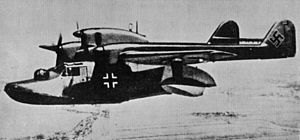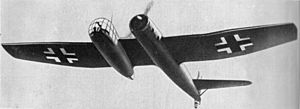Richard Vogt (aircraft designer) facts for kids
Richard Vogt (born December 19, 1894 – died January 1979) was a brilliant German aircraft designer. He was famous for creating unique planes, including the super unusual, asymmetrical Blohm & Voss BV 141 during World War II. After the war, he moved to the United States as part of a special program called Operation Paperclip. There, he continued to design amazing military aircraft for the American forces.
Contents
Early Life and First Plane
Richard Vogt was born in a town called Schwäbisch Gmünd in Germany. He was one of twelve siblings!
When he was a student, he met a famous aircraft designer named Ernst Heinkel. This meeting likely sparked his interest in planes even more. In 1912, at just 18 years old, Richard built his very first airplane. With a friend's help and Heinkel watching, he tried to fly it near his hometown. It didn't quite work, but it showed his passion for flight!
World War I and Becoming a Pilot
After school, Richard worked in an engine factory. When World War I started, he joined the German military. He was injured during the war and sent back home. After recovering, he trained to become a pilot himself.
Starting His Career
In 1916, Richard began working at the Zeppelin factory. There, he was very impressed by another designer, Claude Dornier. This made him decide he wanted to be an aircraft designer too.
After the war, he went to the Technical University in Stuttgart. He studied hard and even earned a doctorate degree. He also got his first patent for an invention during this time.
Designing Planes in Japan
In 1923, Richard Vogt traveled all the way to Kobe, Japan. He worked for Kawasaki, a company that built planes under license from Dornier. He became the chief designer there!
He taught a young Japanese engineer named Takeo Doi everything he knew. Doi later designed the famous Kawasaki Ki-61 Hien fighter plane. While in Japan, Vogt designed several aircraft, including the Kawasaki Type 92 biplane fighter and the Kawasaki Type 88 reconnaissance plane. He stayed with Kawasaki for ten years, until 1933.
Building for Blohm & Voss
In 1933, Richard Vogt was offered a big job back in Germany. He became the Chief Designer at Hamburger Flugzeugbau, a new aircraft company started by the Blohm+Voss shipbuilders.
On his flight back from Japan, he came up with a clever idea: a main wing spar (the main support beam of a wing) made of hollow steel. This spar could also be used as a strong, armored fuel tank! Most of his future designs used this smart idea.
Vogt's most famous and unusual idea was an asymmetrical aircraft. This meant the plane was not the same on both sides. The engine and propeller were on one side, and the pilot's cockpit was on the other. This gave the pilot a super clear view! This design was used in the Blohm & Voss BV 141 reconnaissance plane. About 20 of these unique planes were built.
Just before World War II began, Hamburger Flugzeugbau changed its name to the aircraft division of Blohm & Voss. So, Vogt's plane designs changed from "Ha" (for Hamburger) to "BV" (for Blohm & Voss). For example, the Ha 141 became the BV 141.
Vogt also designed many large flying boats, which are planes that can land on water. The Blohm & Voss BV 238 was the biggest and heaviest aircraft built by Germany and its allies during the war. He also worked on special gliding bombs, but they had problems and weren't used much in battle.
A British magazine called Aeroplane even made a funny poem about his unique designs:
Richard Vogt, that original man,
Turns out aeroplanes uglier than
Most any other designer can.
Here is shown on Baltic Sea
A typical Vogt monstrosity—
The One-Three-Eight by B. & V.
Vogt's last big idea was a "pfeilflieger" (meaning "arrow flyer") design. These planes had swept-back wings and no tail, which was perfect for the new jet engines being developed. One of his final designs, the Blohm & Voss P 215 fighter, was even ordered for testing just weeks before the war ended.
Working in America
After World War II, Richard Vogt was invited to the United States as part of "Operation Paperclip". This was a program where American forces brought German scientists and engineers to the US to help with their own research.
From 1947 to 1954, he worked for the US Air Force's Research Laboratory in Dayton, Ohio. Later, he became the chief designer for the Aerophysics Development Corporation until 1960.
From 1960 to 1966, he worked at Boeing, a very famous American aircraft company. He was part of the team led by George S. Schairer, a top expert in aerodynamics (how air moves around objects). At Boeing, Vogt helped design systems for planes that could take off straight up (called vertical takeoff) and also worked on hydrofoils (boats that lift out of the water when moving fast).
He also made an important discovery about wings. He found that small extensions added to the tips of wings could make planes fly further and more efficiently! These extensions are now called winglets and are used on many modern aircraft you see today. His last project at Boeing was helping to evaluate the design of the huge Boeing 747 after it was launched.
Retirement and Later Life
After retiring from Boeing, Richard Vogt enjoyed designing a safe sailboat that wouldn't tip over. He also started writing his life story. Sadly, in 1977, a fire destroyed his house, and he lost many of his personal and work documents.
Death
Richard Vogt passed away in January 1979 in Santa Barbara, California, at the age of 84.
Personal Life
Richard Vogt was married and had two sons.
Aircraft Designed
Here are some of the aircraft Richard Vogt designed that were actually built and flown:
- In Japan
- Kawasaki KDA-2 Army Type 88 biplane reconnaissance (1927, 710 built)
- Kawasaki KDC-2 Four passenger version of Type 88 (1928, 2 built)
- Kawasaki KDA-3 Single-seat fighter (1928, 3 built)
- Kawasaki KDA-5 Army Type 92 biplane fighter (1930, 385 built)
- In Germany
- Hamburger Flugzeugbau Ha 136 Advanced monoplane trainer (1934, two built)
- Hamburger Flugzeugbau Ha 137 Close-support aircraft/dive bomber (1935, six built)
- Blohm & Voss BV 138 Maritime reconnaissance flying boat (1937, 279 built)
- Blohm & Voss Ha 139 Transport / reconnaissance seaplane (1936)
- Blohm & Voss Ha 140 Torpedo bomber seaplane (1937, four built)
- Blohm & Voss BV 141 Reconnaissance aircraft (1938, 38 built)
- Blohm & Voss BV 142 Landplane version of the BV 139 transport
- Blohm & Voss BV 144 Tilt-wing transport, built in France
- Blohm & Voss BV 155 High-altitude interceptor (1944, three built)
- Blohm & Voss BV 222 Transport / reconnaissance flying boat Viking (1940, 13 built)
- Blohm & Voss BV 238 Reconnaissance flying boat (1944, one built)
- Blohm & Voss BV 246 Radio-guidable glide bomb (1945, approximately 1,100 built)
- Blohm & Voss BV 40 Interceptor glider



